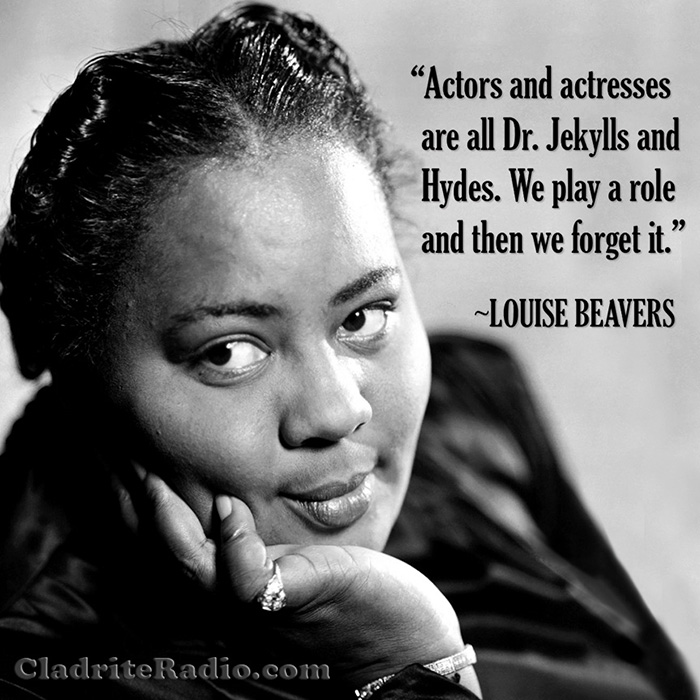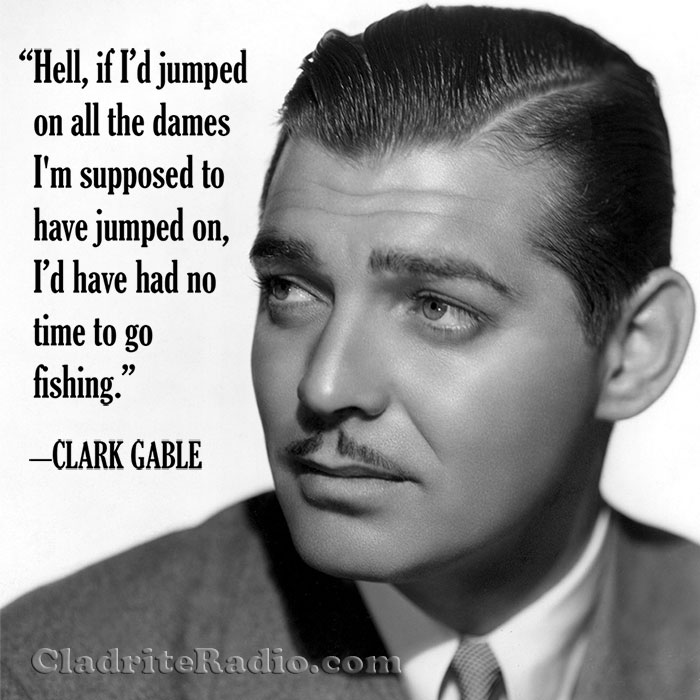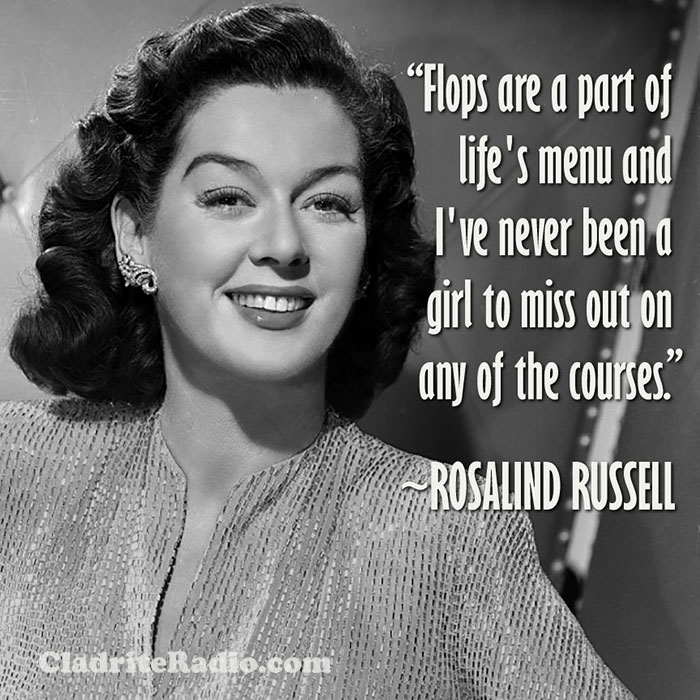Here are 10 things you should know about Rosalind Russell, born 114 years ago today. A terrific actress, she also strikes us as having been a decent, down-to-earth person—the kind of gal it’d be fun to have a couple of drinks with at a favorite watering hole.
Tag: Claudette Colbert
Happy Birthday, Rosalind Russell
Happy 115th Birthday, Louise Beavers!
The delightful Louise Beavers was born 115 years ago today in Cincinnati, Ohio. Beavers made the very most of the extremely limited opportunities Hollywood offered African American performers in her time, but we can’t help but mourn for what might have been, for Beavers and for so many other black actresses and actors. Here are 10 LB Did-You-Knows:
- Beavers’ father, a school teacher, moved the family to Pasadena, California, when Louise was 11 years ago. While Beavers attended Pasadena High School, her mother, a voice teacher, trained her daughter for the concert stage, but Beavers instead joined an all-female minstrel company called “Lady Minstrels” and spent time in vaudeville. She also worked as a dressing room attendant for a photographer, a nurse, and as a personal maid to silent film star Leatrice Joy.
- A Central Casting Bureau talent scout named Charles Butler saw Beavers perform and urged her to try for a movie role. Beavers was hesitant due to the typically derogatory portrayal of African Americans in pictures at the time, but she was finally persuaded and won a role in Uncle Tom’s Cabin (1927).
- Though Beavers broke into movies near the end of the silent era, she smoothly made the transition into talkies, making more than 75 film appearances by 1935—she appeared in twenty pictures in 1933 alone! Though Beavers’ roles were (sadly) limited to the sort of maid, mammy and slave characters that black actresses were restricted to in those days, she brought a sense of wisdom, warmth and gentleness to them that allowed her to rise above their inherently cardboard, stereotypical nature.
- In 1934, Beavers was given a breakout role in Imitation of Life opposite Claudette Colbert. In that film, she plays Delilah Johnson, a single mother who agrees to serve as a housekeeper for a white widow named Bea Pullman (Colbert) in exchange for room and board for her and her daughter. Delilah and Bea team to open a pancake recipe (using Delilah’s secret recipe) and together become very wealthy, though their respective relationships with their daughters become strained. Beavers was billed fourth for the film, but anyone who’s seen the picture knows that she deserved equal billing with Ms. Colbert, not only for the size and importance of her role but for the memorable and moving performance she delivered.
- After that moment in the spotlight, though, Beavers returned to playing the secondary characters she’d always played, bringing humanity to them but leaving us 21st century movie buffs bemoaning what might have been if had Beavers been allowed to build on her wonderful work in Imitation of Life.
- Beavers was just a year older than Fredi Washington, who played her daughter in Imitation of Life.
- Like other black performers of the day, Beavers sometimes came in for criticism from the African-American community for accepting the kind of derogatory roles Hollywood offered. She defended herself and performers like her, saying, “I am only playing the parts. I don’t live them,” but as she became more successful and better known, she began to speak out more about Hollywood’s poor treatment of black performers.
- Even after finding success in movies, Beavers continued to work in live theatre, taking part in annual tours of twenty weeks’ duration.
- Beavers was the third of three actresses to portray Beulah Brown on the comedic television program The Beulah Show, which began as a radio show before moving to TV. Ethel Waters originated the role on television, followed by Hattie McDaniel, whose health forced her to drop out after just six episodes, at which point Beavers came in as her replacement. The show came in for criticism for its stereotypical characters, but it was the first sitcom to star an African-American performer.
- Among the more than 150 features and shorts in which Beavers appeared are Our Blushing Brides (1930), What Price Hollywood? (1932), 42nd Street (1933), The Story of Temple Drake (1933), Bombshell (1933), Make Way for Tomorrow (1937), Made for Each Other (1939), Mr. Blandings Builds His Dream House (1948) and The Jackie Robinson Story (1950).
Happy birthday, Louise Beavers, wherever you may be!

Happy 116th Birthday, Clark Gable!
Clark Gable was born William Clark Gable 116 years ago today in Cadiz, Ohio. In his day, he was known as the King of Hollywood or, often, just as the King. Here are 10 CG Did-You-Knows:
- Gable was named after his father, William, who was an oil well driller, but even as a child, he was referred to by his middle name or sometimes as Billy. His birth certificate mistakenly listed Gable as female.
- Gable’s stepmother (his birth mother died when he was young) encouraged his interest in music, teaching him to play piano. He later took up brass instruments and at age 13, he was the only teen to play in the men’s town band. Gable’s father encouraged him from an early age to be well-dressed and well-groomed.
- At 17, Gable decided he decided to pursue a career in the theatre and by 21, he was touring in stock companies, along with jobs in the oil fields and working with horses. Josephine Dillon, an acting coach and theatrical manager in Portland, Oregon, set out to remake Gable from head to toe. She paid for him to get new teeth, she built up his once-slight physique with a proper diet and strenuous exercise and helped him improve his movements and posture. She also worked at length to lower his high-pitched voice and improve his diction.
- Dillon, who was 17 years Gable’s senior, also financed Gable’s relocation from Portland to Hollywood in 1924, where she officially became his manager and his wife. He changed his professional name from W. C. Gable to Clark Gable and began to work as an extra and a bit player in silent short and features.
- When no leading film roles were in the offing, Gable returned to the stage, acting for a season with the Laskin Brothers Stock Company in Houston, Texas, where he played a variety of roles and gained valuable experience. Finally, with the ascent of talking pictures, Gable’s stock as an actor rose as well. He was offered a contract with MGM in 1930. His first role was as a rough-hewn villain in a William Boyd western, The Painted Desert (1930). His imposing stature and now-powerful speaking voice made a quick hit with moviegoers (especially female ones).
- Many of Gable’s early roles were tough guys, gangsters and villains, and though no less an authority than Darryl F. Zanuck had once said of Gable, “His ears are too big and he looks like an ape,” he was finding himself cast opposite popular leading ladies of the day, including Joan Crawford, Barbara Stanwyck, Norma Shearer and even Greta Garbo (with whom he shared a mutual dislike—she thought his acting wooden; he thought her a snob).
- Despite long being known as the King of Hollywood, Gable was never No 1 at the box office in a given year, but year after year, he ranked near the top, as the fortunes of other actors rose and fell. His breakthrough role was his Oscar-winning performance in Frank Capra‘s It Happened One Night in 1934, opposite Claudette Colbert. That classic film won the Best Picture Oscar to go along with Gable’s Best Actor nod. Capra considered the role of Peter Warne in the film the closest to Gable’s actual personality: “It Happened One Night is the real Gable,” he wrote. “He was never able to play that kind of character except in that one film. They had him playing these big, huff-and-puff he-man lovers, but he was not that kind of guy. He was a down-to-earth guy, he loved everything, he got down with the common people. He didn’t want to play those big lover parts; he just wanted to play Clark Gable, the way he was in It Happened One Night, and it’s too bad they didn’t let him keep up with that.”
- Gable is said to have been Adolph Hitler‘s favorite actor, and it’s been reported that Hitler offered a reward to anyone who could capture Gable, then flying combat missions over Germany, and bring him to Hitler unharmed. The reward went unclaimed.
- Gable played a newspaper reporter in nine different pictures, more than any other type of role, but late in life, he expressed regret that he hadn’t appeared in more westerns, the genre he most enjoyed working in.
- Gable was married five times, the first two times to women many years his senior, but it is generally accepted that his third Wife, actress Carole Lombard, was the great love of his life. She even got Gable, a lifelong Republican, to support Franklin Delano Roosevelt for president. It’s said that Lombard’s tragic death in a plane crash in 1942 left Gable so bereft that he immediately enlisted in the Army Air Corps and was absent from the silver screen for three years.
Happy birthday, Clark Gable, wherever you may be!

Happy 112th Birthday, Constance Bennett!
Actress Constance Bennett was born 112 years ago today in New York City. Here are 10 CB Did-You-Knows:
- Bennett was born into a theatrical family. Both her parents, Richard Bennett and Adrienne Morrison, were actors, as was her maternal grandparents, Rose Wood and Lewis Morrison.
- Bennett’s two sisters, Joan and Barbara, were also actresses (though Barbara’s career was brief), but it was Constance who was the first to enter motion pictures, appearing in silent pictures filmed in and around NYC and making her Hollywood debut in Cytherea (1924).
- After giving up films upon marrying Philip Plant in 1925, Bennett, after divorcing Plant, returned to her film career just as talking pictures were taking off.
- Bennett was, for a brief time in the early 1930s, the highest paid actress in Hollywood.
- Like Kay Francis, Bennett’s ability to wear fine clothes well played a big role in her success.
- Bennett Was cast in the role of Ellie Andrews in It Happened One Night but withdrew when Columbia Pictures declined to allow her to serve as producer of the film. Claudette Colbert, who took over the role, won the Best Actress Oscar for her work in the picture.
- Bennett starred in the Janet Gaynor/Judy Garland/Barbra Streisand role in What Price Hollywood (1932), which was a clear inspiration for the A Star Is Born pictures.
- Less in demand in pictures by the 1940s, Bennett began working in radio and in the theatre. Her stage debut came in 1940 in Noël Coward‘s Easy Virtue.
- Bennett Was married five times; the final marriage, to US Air Force Colonel (later Brigadier General) John Theron Coulter, lasted by far the longest—from June 1946 until Bennett’s death in July 1965.
- Because of her marriage to Coulter and in recognition of her efforts in providing relief entertainment to US troops stationed in Europe during and after World War II, Bennett was buried in Arlington National Cemetery.
Happy birthday, Constance Bennett, wherever you may be!


